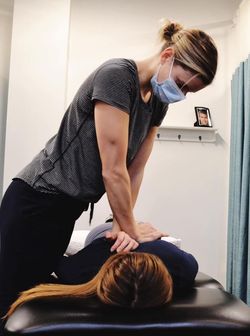
Back pain
ConnectTherapy and the Thoracic Ring Approach
Have you been experiencing back pain that has not resolved with conventional treatment? Have you been having trouble taking a deep breathe? Are you involved in a rotational sport such as golf and want to improve your game?
ConnectTherapy™ was developed by Dr. Linda-Joy Lee to help therapists and patients understand the construct of connectedness. How are different regions and systems of the body connected? How are the body and mind connected? How are therapists and clients connected? How are we as humans physically, emotionally and socially connected?
Whereas low back and pelvic pain have received considerable research interest, research on the thorax remains limited. ConnectTherapy is the evolution of total body assessment and treatment framework designed to understand and treat the whole individual. ConnectTherapy is rooted in Dr. Lee’s innovative Thoracic Ring Approach™.
Been going here consistently for over 1 year now to deal with some chronic issues, can’t recommend enough, always leave feeling better.
Tara Freeman
The Thoracic Ring approach
Historically, therapists have assessed the function of the thoracic spine separately from the function of the ribs. Based on anatomical and biomechanical data, Dr. Lee has proposed that the most accurate evaluation of thorax function is based on the understanding of the thoracic ring. The Thoracic Ring Approach employs palpation points and forces around the ribcage to assess and treat the rings in an integrated, three-dimensional model.
The Thoracic Ring approach and treatment
The most common treatment techniques used in practice work on increasing the mobility of the thorax, which is contradictory to the belief that the thoracic spine is stiff. The Thoracic Ring Approach moves away from conceptualizing the thorax as a static, stiff box, to being a dynamic stack of ten rings, much like a “slinky” (imagine Ace Ventura coming down from Buddhist temple with a slinky). This dynamic view of the thorax means that an essential component of treatment is training optimal muscle activation patterns and muscle balance around the thoracic rings. A variety of techniques such as manual therapy, taping, needling and self release techniques are used to release non-optimal muscle patterns to create an opportunity to train new muscle patterns.
When there is a loss of optimal muscle sequencing around the thoracic rings, there are many possible consequences throughout the whole body. These consequences can result in non-optimal loading of multiple structures and regions of the body that can drive conditions such as hip osteoarthritis, impingement, groin pain, pelvic girdle & low back pain, shoulder impingement, lumbar instability and headaches.
For more information, visit Dr. LJ Lee’s Connect Therapy website.